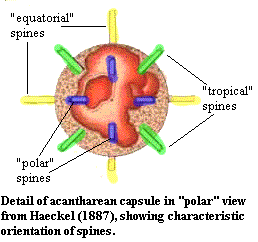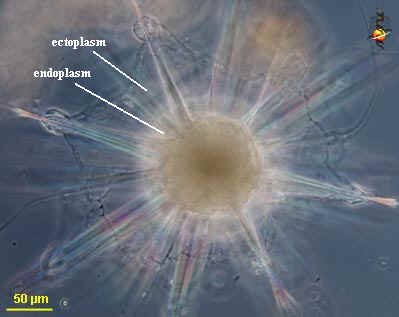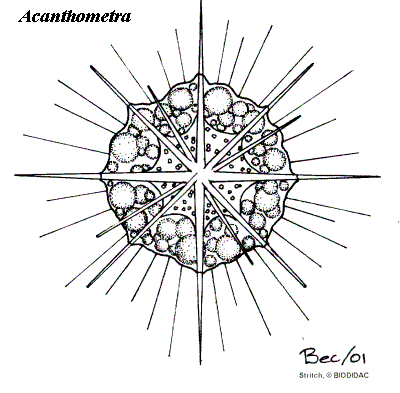Acantharea
Taxa on This Page
-
Acantharea
-
Arthracanthida
-
Chaunacanthida
-
Holacanthida
-
Symphyacanthida
|
This page discusses the Acantharea, one of the several protist groups with a mineral skeleton known collectively as "Radiolaria." This may or may not be a valid taxon. Acantharea are unusual in that the mineral component is strontium sulphate (Sr2SO4). Like other radiolarians, Acantharea have a three-compartment cell: a nucleus (more commonly several nuclei), and inner (endoplasm) and outer (ectoplasm) cytoplasmic compartments, usually separated by a fibrous membrane. The ectoplasm is filled with small membrane-bound vacuoles containing gas or food in the process of digestion. The endoplasm contains symbiotic algae, the mitochondria, and other organelles.
The Acantharea were named by Ernst Haeckel in 1887, who wrote an extensive monograph based on four years of field work during the scientific expedition of the HMS Challenger. That monograph is still the basis of much of our knowledge of Acantharea. He noted that, in Acantharea, the mineralized spines grow out from the center. There are almost always 20 spines, distributed in a particular, characteristic way. Acanthareans are classified largely on the basis of the manner in which the spines meet at the center of the cell and on the position of the fibrous capsule separating the two cytoplasmic regions.
Acantharea, like other radiolarians, feed by capturing food particles on pseudopods (long "feelers") which extend from the cell membrane. Food is carried back to the cell body where it is encased in a vacuole and digested. Acantharea also host symbiotic algae in the endoplasm. These zooxanthellae probably supply the host cell with the products of photosynthesis -- oxygen and sugars. Acantharea are normally found fairly deep in the water column in oceanic waters where they float as part of the plankton population. ATW031116. |
 Acantharea: At some point, the spelling seems to have changed from Haeckel's original [H87] "Acantharia" to the current spelling. Both spellings are found in the literature -- sometimes both in the same paper. Haeckel's taxon included the Actinelida in addition to the groups discussed here. It is apparently now agreed that the Actinelida are not closely related [Z+97].
Acantharea: At some point, the spelling seems to have changed from Haeckel's original [H87] "Acantharia" to the current spelling. Both spellings are found in the literature -- sometimes both in the same paper. Haeckel's taxon included the Actinelida in addition to the groups discussed here. It is apparently now agreed that the Actinelida are not closely related [Z+97].
Range: no fossil record. Planktonic marine heterotrophs. Diversity probably grossly undersampled [L+01]. Most of what we know is still derived from Haeckel's 1887 monograph reporting the results of his four year field study during the scientific expedition of the HMS Challenger [H87].
Phylogeny: * : Holacanthida + (Symphyacanthida + (Chaunacanthida + Arthracanthida)).
Acantharea are usually said to be related to the "Radiolaria," [L+02] but the proximity of the relationship is sometimes disputed [Z+97]. Presumably, they are related more or less closely to the amoebae.
The internal phylogeny of the clade is very loosely taken from Lopez-Garcia et al. [L+02]. However, their work was not intended to examine the internal phylogeny of the group. Interestingly, their results suggest that the symphyacanthids are paraphyletic, including both chaunacanthids and arthracanthids. This is consistent with earlier unpublished work by Zettler (former site). Symphyacanthid paraphyly is also reasonable in view of an observation of Haeckel [H87] which seems to suggest that spines of various different groups may sometimes fuse where they meet in the center of the cell (i.e., they approach the symphyacanthid condition).
Characters: Acantharea are free floating planktonic heterotrophs with cosmopolitan distribution. They are rarely found in coastal waters and appear to take up species-specific positions in the water column, often at considerable depth.
Trophic mode: As with other radiolarians, feeding is accomplished by numerous long, thin pseudopodia which extend out from the ectoplasm into the environment. These trap food particles which are carried back to the cell body by cytoplasmic streaming, and phagocytosed when they reach the cell membrane [GM79]. Some of the pseudopodia may be stiffened by a microtubular array similar to an axoneme [GM79].
 Mineral skeleton: Like other radiolarians, Acantharea have an elaborate mineralized skeleton. Unlike other radiolarians, Acantharea possess long spines composed of strontium sulphate (Sr2SO4) which are distributed in a very regular pattern. Some Polycystinea also use strontium salts, as do various orphan groups. Strontium sulphate is relatively soluble, so that the tests dissolve after death and the taxon has no fossil record. The tests take the form of either ten diametric or twenty radial spines which grow outward from the center [H87]. The arrangement of the spines is precise, and is described by what Haeckel calls the "Müllerian law." In essence, the spines can be viewed as groups of 4, falling on 5 lines of latitude. Haeckel described these as an "equatorial" group, two "tropical" groups and two "polar" groups, as shown in the figure [H87]. Since the figure is in "polar" view, only one set each of the "tropical" and "polar" spines are visible. The spine morphology is quite variable, but the proximal end is generally pyramidal, sometimes with a marked constriction just distal to the proximal pyramid [H87].
Mineral skeleton: Like other radiolarians, Acantharea have an elaborate mineralized skeleton. Unlike other radiolarians, Acantharea possess long spines composed of strontium sulphate (Sr2SO4) which are distributed in a very regular pattern. Some Polycystinea also use strontium salts, as do various orphan groups. Strontium sulphate is relatively soluble, so that the tests dissolve after death and the taxon has no fossil record. The tests take the form of either ten diametric or twenty radial spines which grow outward from the center [H87]. The arrangement of the spines is precise, and is described by what Haeckel calls the "Müllerian law." In essence, the spines can be viewed as groups of 4, falling on 5 lines of latitude. Haeckel described these as an "equatorial" group, two "tropical" groups and two "polar" groups, as shown in the figure [H87]. Since the figure is in "polar" view, only one set each of the "tropical" and "polar" spines are visible. The spine morphology is quite variable, but the proximal end is generally pyramidal, sometimes with a marked constriction just distal to the proximal pyramid [H87].
Acanthareans are all built on this general plan. Those (Holacanthida) described as having 10 "diametric" spines, might better be characterized as having 20 radial spines, with pairs of opposite spines joined at the center. Other forms have additional spines, or bear bifurcating spines so as to create the appearance externally of additional spines. Often, the spines are grossly unequal in size, and some or all may bear petal-like flanges proximally or distally. Finally, the cells need not be spherical, and some are strongly elongate along one axis [H87]. In addition, many species have lattice-like shells joined to the spines which are somewhat similar in form to the shells of other radiolarians [GM79]. Haeckel erected his taxonomy largely around these secondary symmetries. Schewiakoff completely revised this classification system in a 1926 monograph [1]and superimposed a scheme which emphasized the manner in which the spines were joined (or not) in the endoplasm, and the size of the capsule. This is essentially the taxonomic system employed today [L+80].
Motility: Acantharea have no propulsive organelles in trophic form but may have flagellated stage and/or amoebas and/or cysts at points in their life cycle. It is speculated that acanthareans have a number of buoyancy control mechanisms to regulate their position in the water column. For example, the use of strontium may be related to its higher density, relative to calcium, which is advantageous for buoyancy control [Z+97]. In this respect the greater solubility of strontium salts may be advantageous, since a constant flux of strontium provides a method for varying the density of the cell. After death, the strontium sulphate spines dissolve in a few hours [GM79]. Accordingly, the rate of strontium exchange with the environment is probably relatively rapid even in life.
Plasma membrane: Acantharea have a thin outer capsule. The outside face of cytoplasm coated with a fibrous cortex that is joined to spicules by contractile myonemes. The plasma membrane is associated with concentric extrusomes.
Ectoplasm: As in other Radiolaria, Acantharea have a gelatinous ectoplasm filled with vacuoles, separated from the inner cell mass by a fibrous capsular wall.
Cytoskeleton: The central capsule is made up of microfibrils arranged into twenty plates, each with a hole through which one spine projects, and there is also a microfibrillar cortex linked to the spines by myonemes. These assist in flotation. The axopods of Acantharea are fixed in number. Axopodia arising from unspecified sites in the cytoplasm but having an open hexagonal or larger polygonal arrays of microtubules.
Capsule: Most acanthareans have a fibrous capsule separating endoplasm and ectoplasm [H87] [GM79]. The capsule of acanthareans differs from other radiolarians in being uniformly pierced by very small pores [H87] [GM79]. It is said to be "of a different cellular origin" than the capsule of other radiolarians. [Z+97].
Endoplasm: Acanthareans host symbiotic zooxanthellae in the endoplasm [H86] [GM79]. The endoplasm may also contain pigment granules and oil vacuoles [H86]. The respiratory gases produced by the zooxanthellae may also be used as a method of controlling buoyancy [GM79].
Mitochondria: Mitochondria with tubular cristae.
Nuclei: Many (most?) species are multinucleate. [Z+97].
Genetics & reproduction: Reproduction takes place by formation of spores, which may be flagellate, which develop into mononucleate amoebae. Adults are usually multinucleate. Mitosis involves an eccentric spindle located inside an intact nuclear envelope.
Notes: [1] Schewiakoff, W (1926), Die Acantharia des Golfes von Neapol. Flora e Fauna del Golfo di Napoli 37, 755 pp.
Links: Acantharea - Wikipedia; text.htm reproduction of Haekel's original description. Unfortunately, the terminology has changed so much that it is nearly useless); PNAS -- Abstracts- Zettler et al. 94 (21)- 11411; 4Reference || Acantharea; Sarcodia- Actinopoda- Acantharea Japanese); Subject Categories of the Division F. Life Sciences see Zettler abstract); acantharea.htm; Entities Microscope); Обзор групп царства Protista (включая грибы Mycota).
References: Goll & Merinfeld (1979) [GM79], Haeckel 1887) [H87], Lopez-Garcia et al. (2001) [L+01], Lopez-Garcia et al. (2002) [L+02], Zettler et al. (1997) [Z+97]. ATW031114
 Holacanthida: Acanthochiasma, Acanthocolla, Acanthoplegma, Acanthospira
Holacanthida: Acanthochiasma, Acanthocolla, Acanthoplegma, Acanthospira
Range: no fossil record.
Phylogeny: Acantharea : (Symphyacanthida + (Chaunacanthida + Arthracanthida)) + *.
Characters: 10 or 16 diametric spines, similar or dissimilar, with or without excrescences [L+80]; diametric spines, simply crossed [L+80]; capsular membrane absent or located far outside central cell mass [L+80]; encystment phase? [L+80].
Gametogenesis takes place in an oval cyst after complete remodeling of the cell.
Links: Microscope; Sarcodia- Actinopoda- Acantharea- Holacanthida Japanese); 4Reference || Acantharea.
References: Levine et al. (1980) [L+80]. ATW031114
 Symphyacanthida: Acantholithium, Amphilithium, Amphibelone, Astrolithium, Astrolonche, Dicranophora, Haliommatidium, Heliolithium, Pseudolithium
Symphyacanthida: Acantholithium, Amphilithium, Amphibelone, Astrolithium, Astrolonche, Dicranophora, Haliommatidium, Heliolithium, Pseudolithium
Range: no fossil record.
Phylogeny: Acantharea :: (Chaunacanthida + Arthracanthida) + *.
Characters: 20 radial spines [L+80]; bases of the 20 radial spines fused into a star-like structure called a central body [L+80]; capsular membrane located far outside central cell mass [L+80] (or absent?); encystment phase? [L+80].
Links: Microscope; Sarcodia- Actinopoda- Acantharea- Symphyacanthida (Japanese); Subject Categories of the Division F. Life Sciences (Zettler abstract); 4Reference || Acantharea; ACTINOPODOTISTA.
References: Levine et al. (1980) [L+80]. ATW031114
 Arthracanthida: Acanthometra, Dorataspis, Lithoptera.
Arthracanthida: Acanthometra, Dorataspis, Lithoptera.
Range: no fossil record.
Phylogeny: Acantharea ::: Chaunacanthida + *.
Characters: Acantharea in which the bases of the spicules are pyramidal with 4-6 facets with or without basal extensions forming a more or less interlinked system [L+80]. Endoplasm with numerous nuclei, pigments, inclusions and symbiotic Haptophyta. Thick capsular wall. Capsular membrane close to central cell mass. Ectoplasm separated from endoplasm by a periplasmic cortex. Myonemes cylindrical, generally numerous. A few axopodia emerge between the spicules. Unlike the other orders of Acantharia, gametogenesis occurs in a gamont which keeps the appearance of the trophont. The whole endoplasm is converted. radial spines, with pyramidal bases packed together. No encystment phase [L+80].
Note: the foregoing description is essentially verbatim from Microscope.
Links: Microscope; Sarcodia- Actinopoda- Acantharea- Arthracanthida Japanese); Phylogenetic relationships between the Acantharea and the ...; 4Reference || Acantharea.
References: Levine et al. 1980) [L+80]. ATW031114
checked ATW061221, edited RFVS111206
 Acantharea: At some point, the spelling seems to have changed from Haeckel's original [H87] "Acantharia" to the current spelling. Both spellings are found in the literature -- sometimes both in the same paper. Haeckel's taxon included the Actinelida in addition to the groups discussed here. It is apparently now agreed that the Actinelida are not closely related [Z+97].
Acantharea: At some point, the spelling seems to have changed from Haeckel's original [H87] "Acantharia" to the current spelling. Both spellings are found in the literature -- sometimes both in the same paper. Haeckel's taxon included the Actinelida in addition to the groups discussed here. It is apparently now agreed that the Actinelida are not closely related [Z+97]. Mineral skeleton: Like other radiolarians, Acantharea have an elaborate mineralized skeleton. Unlike other radiolarians, Acantharea possess long spines composed of strontium sulphate (Sr2SO4) which are distributed in a very regular pattern. Some
Mineral skeleton: Like other radiolarians, Acantharea have an elaborate mineralized skeleton. Unlike other radiolarians, Acantharea possess long spines composed of strontium sulphate (Sr2SO4) which are distributed in a very regular pattern. Some 

